
Postage Stamps of the United States - 1912
Politics
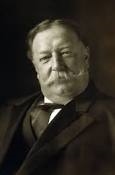 President
President
William Howard Taft
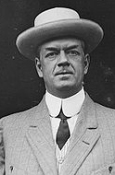
Postmaster General:
Frank H. Hitchcock
Music
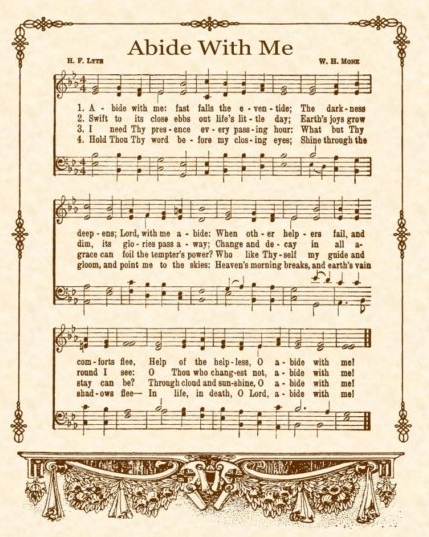
Click Control Above To Hear
1912 "Abide With Me"
Postage Rates
Domestic Letter Rate: 2¢ per oz.
Postcard Rate: 1¢
Registry Fee: 10¢
Foreign Rate: 5¢
Stamps
The New Washington Franklin Designs First Issued in 1912
Flat Plate - Perf 12 - Single-Line Watermarked on Soft Porous Paper

400 Subject Plates
Issue Date: Jan. 11, 1912

400 Subject Plates
Issue Date: Feb. 12, 1912

400 Subject Plates
Issue Date: Feb. 12, 1912

400 Subject Plates
Issue Date: Feb. 12, 1912

400 Subject Plates
Issue Date: Feb. 12, 1912

200 Subject Plates
Issue Date: Feb. 12, 1912

200 Subject Plates
Issue Date: Feb. 12, 1912
The New Designs of the Regular Issues of 1912
According to the Post Office Department - A Description of United States Stamps - the ordinary postage stamps of the 1908 issue, i.e. the Washington-Franklins, "while possessing high artistic merit, have given considerable trouble to the public and to the Postal Service on account of the similarity of designs of the different denominations." They go on to say that only six colors were available and that stamps above the 6¢ denomination would necessarily have to be printed in shades of the original six colors. In particular, there was some confusion between the 1¢ green and the 8¢ light green stamps, and worse, between the 3¢ purple and the 50¢ lavender (violet) stamps. Although in the strictest sense, six colors - green, red, purple, brown, blue, and orange - were all that they had to work with, one could argue that at least three more very distinct colors could have been used - yellow, gray and black - but even nine colors would not have met the need for the many denominations of the time.
By placing Washington on all denominations through the 6¢ stamp and later the 7¢ stamp, and Franklin on all denominations 8¢ and above it was hoped that the various denominations would be more discernable. The compromise made may seem simple enough, but it entailed replacing Franklin on the one cent stamp, a tradition that had not been broken since the first one cent stamps were printed in 1851. The higher denomination Franklin stamps were printed in the various shades of the lower denomination Washington stamps, and to further distinguish the stamps, the frames were altered slightly. "U.S. POSTAGE" was bent around the oval frame of the vignette and enclosed in panels, "CENTS" and "DOLLAR" were enclosed in a somewhat trapezoidal frame, and the laurel leaves and ribbons were replaced by smaller clusters of oak leaves.
In addition to the stamps pictured, further denominations were added in 1914, 1915, and 1918. The 13¢ stamp was discontinued, since its primary purpose was to pay the postage and registry fee on foreign mailings, and when this was increased to 15¢, the thirteen cent stamp became obsolete.
In 1919, the 13¢ stamp was re-issued, although in the Franklin format, to pay either the 3¢ letter plus the 10¢ special delivery fee or the 3¢ letter plus the 10¢ registry fee.
The Parcel Post Issues of 1912
Flat Plate - Perf 12 - Single-line Watermark - 180 Subject Plates
See 1913 for additional issues
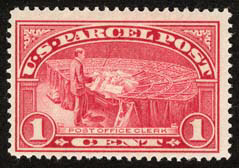
Issue Date: Nov. 27, 1912
209,691,094 million issued
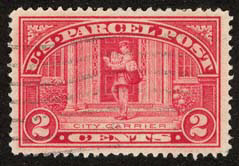
Issue Date: Nov. 27, 1912
206,417,253 million issued
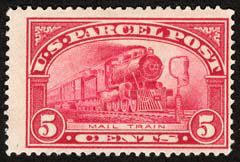
Issue Date: Nov. 27, 1912
108,153,993 million issued
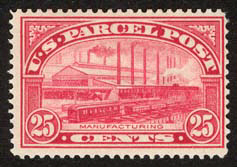
Issue Date: Nov. 27, 1912
21,940,653 million issued
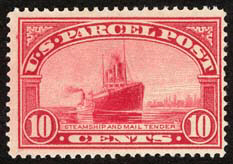
Issue Date: Dec. 9, 1912
56,896,653 million issued
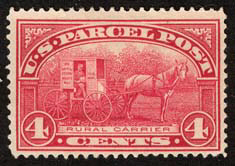
Issue Date: Dec. 12, 1912
76,743,813 million issued
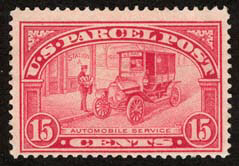
Issue Date: Dec. 16, 1912
21,147,033 million issued
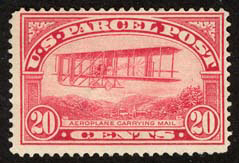
Issue Date: Dec. 16, 1912
17,142,393 million issued
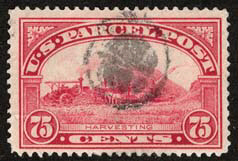
Issue Date: Dec. 18, 1912
2,772,615 million issued
Prior to 1912, private companies controlled the delivery of parcels throughout the U.S. There was a lot of money to be made delivering these parcels, and the private companies lobbied heavily against the U.S. Post Office entering the business. Unfortunately, just as it is today, the more lucrative markets were where the population densities were the highest, meaning rural areas and particularly farmers were not getting proper service. On August 24, 1912, Congress approved a law providing for parcel post service and authorized the production of stamps to pay the parcel fees, to be effective January 1, 1913.
Twelve stamps were authorized for this service, in three sets of four, with the first four stamps representing the workers that delivered the mail, the second four representing the transportation methods for delivering that mail, and the final set of four representing the industries which would be using this new service. The nine stamps above were released to Post Offices prior to the Jan. 1 date. Three other stamps were issued after the January "deadline", the 3¢, 50¢ and $1 stamps.
The twenty cent stamp holds the special distinction of being the first stamp in the world to depict an airplane, some six years prior to the institution of the U.S. airmail stamps.
The similarity of color and design size led to some confusion among users as well as postal workers, so much confusion in fact that by March the Postmaster was considering alternatives to the color and design of the stamps, including reducing the size and changing the colors to match the denominations of the ordinary stamps. Further aggravating the problem for postal employees was the fact that the stamps were printed in sheets of 180, meaning four panes of 45, an odd number for accounting purposes. It was finally decided that the purpose for which the Parcel Post stamps had been issued, to keep an account of the revenue from the Parcel Service, could be accomplished more efficiently by other methods. On July 1, 1913, only six months after the Parcel Post regulations went into effect, the Parcel Post stamp lost its distinction, ordinary postage stamps were now valid for paying the parcel fee.
The Parcel Postage stamps were still valid for postage on ordinary mail, as well as for parcels. Many of the 1¢ Parcel Post stamps were used to pay the postcard rate and are sometimes found today on postcards from the era.
The Parcel Post Postage Dues Issued in 1912
Flat Plate - Perf 12 - Single-line Watermark -180 Subject Plates
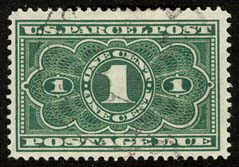
Issue Date: Nov. 27, 1912
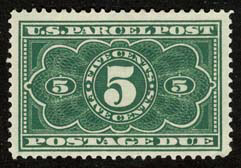
Issue Date: Nov. 27, 1912
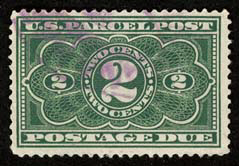
Issue Date: Dec. 9, 1912
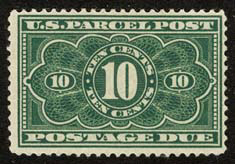
Issue Date: Dec. 12, 1912
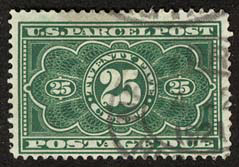
Issue Date: Dec. 16, 1912
The Parcel Post Postage Due Stamps were just what their name implies, they paid the makeup fee for underpaid parcels, just as the normal postage due stamp paid the fee for underpaid correspondence. Their existence mirrored the Parcel Post stamps, see above, and their usefulness died on July 1, 1913, just as the Parcel Post stamps had. They were, however, still valid for regular postage due usage after that date.
The following postage stamp varieties were first issued by the U.S. in 1912
No new varieties of U.S. commemorative stamps were issued in 1912
No new varieties of the U.S. Special Delivery stamps were issued in 1912
Ordinary issue:
Flat Plate - Perf 12 unless otherwise noted
Designer: C. Aubrey Huston, based on the profile from Houdon's busts of Washington and Franklin
Engravers: Marcus W. Baldwin, Edward M. Hall and Robert Ponickau
Number 395 - 4¢ Washington perf 8½ vertically - EDU: 6/21/12
Number 405 - 1¢ Washington perf 12 - EDU: 2/2/12
Number 405b - 1¢ Washington perf 12 booklet (pane) - EKU: not known
Number 406 - 2¢ Washington perf 12 - EDU: 2/15/12
Number 406a - 2¢ Washington perf 12 booklet (pane) - EDU: 5/2/12
Number 408 - 1¢ Washington imperforate S/L watermarked - EKU: not known
Number 408V Vertical Coil - 1¢ Washington imperf. from a vertical strip S/L Wmk - EDU: 5/17/12
Number 408H Horizontal Coil - 1¢ Washington imperf. from a horiz. strip S/L Wmk - EDU: not known
Number 409 - 2¢ Washington imperf. S/L Wmk denomination in numerals - EDU: 3/21/12
Number 409V Vertical Coil - 2¢ Washington imperf. from a vertical strip S/L Wmk - EDU: 5/29/12
Number 409H Horizontal Coil - 2¢ Washington imperf. from a horiz. strip S/L Wmk - EDU: 12/17/14
Number 410 - 1¢ Washington perf 8½ horizontally - EDU: 4/17/12
Number 411 - 2¢ Washington perf 8½ horiz. denomination in numerals - EDU: 6/12/12
Number 412 - 1¢ Washington perf 8½ vertically - EDU: 5/21/12
Number 413 - 2¢ Washington perf 8½ vert. denomination in numerals - EDU: 4/16/12
Number 414 - 8¢ Franklin perf 12 - EKU: 4/20/12
Number 416 - 10¢ Franklin perf 12 - EDU: 2/12/12
Number 418 - 15¢ Franklin perf 12 - EDU: 4/26/12
Number 422 - 50¢ Franklin perf 12 double-line watermarked - EDU: 10/31/14
Number 423 - $1 Franklin perf 12 double-line watermarked - EDU: 7/15/15
Postage Dues: For designs of this series see: the Postage Dues of 1894
Number J50 - 50¢ Postage Due perf 12 watermarked - EKU: Sept. 3, 1912
Parcel Post:
Flat Plate - Perf 12 - Designer: C. Aubrey Huston
First Day Covers - July 1, 1913 (after the issue was discontinued and became valid for general postage)
Number Q1 - 1¢ Post Office Clerk - Engravers: J. Eissler, Marcus W. Baldwin, Edward M. Hall
Number Q2 - 2¢ City Carrier - Engravers: J. Eissler and Edward M. Hall
Number Q4 - 4¢ Rural Carrier - Engravers: M. W. Baldwin, E. Myers, E. M. Hall, J. Benzing and H. Charlton
Number Q5 - 5¢ Mail Train - Engravers: C. Chalmers, E. M. Hall, J. Eissler and E. Myers
Number Q6 - 10¢ Steamship and Mail Tender - Engraver: C. Chalmers
Number Q7 - 15¢ Automobile Service - Engravers: L. S. Schofield, J. Benzing, E. M. Hall and E. Myers
Number Q8 - 20¢ Airplane Carrying Mail - Engravers: H. Charlton, E. M. Hall and J. Benzing
Number Q9 - 25¢ Manufacturing - Engravers: H. Charlton, E.Myers and E. M. Hall
Number Q11 - 75¢ Harvesting - Engravers: C. M. Chalmers, M. W. Baldwin, E. M. Hall, F. Lamasure, and E. Myers
Parcel Post Postage Dues:
Number JQ1 - 1¢ Parcel Post Postage Due
Number JQ2 - 2¢ Parcel Post Postage Due
Number JQ3 - 5¢ Parcel Post Postage Due
Number JQ4 - 10¢ Parcel Post Postage Due
Number JQ5 - 25¢ Parcel Post Postage Due





